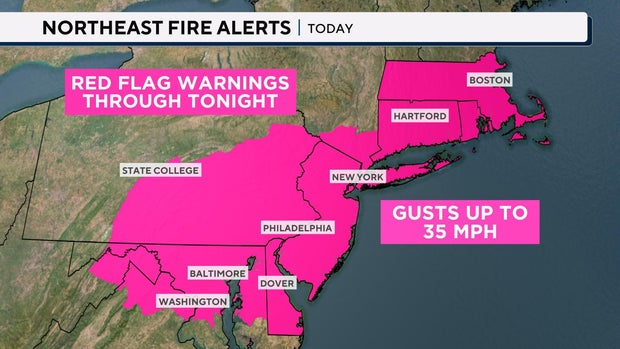CBS News
Maps show drought and fire conditions in Northeast states

The Northeastern U.S. is experiencing ongoing drought conditions, which is helping to fuel an uptick in fire danger. For Friday, an elevated fire weather outlook was issued by the National Weather Service’s Storm Prediction Center for the area stretching from Massachusetts to the northern edge of Virginia and West Virginia.
CBS News
The threat with this elevated fire risk is due to winds picking up to 10-15 mph, with wind gusts upwards of 25-35 mph. Relative humidity levels are as low as 20% in some spots, as well. Red flag warnings have been issued into the evening hours of Friday across parts of the Northeast and New England.
CBS News
The weekly drought monitor came in on Thursday, and 57% of the Tri-State area of metro New York, New Jersey and Connecticut is under a moderate drought. Brushfires flared up along the New Jersey Palisades overnight while firefighters fought other blazes in southern New Jersey, and multiple wildfires have been burning in Massachusetts, where drought conditions range from moderate to severe.
CBS News
Here’s more on the conditions states in the region are facing:
For Massachusetts, 84% of the state is in MODERATE drought while 32% is in SEVERE drought. Boston received its last measurable rainfall on Oct. 30 of 0.18 inches. Boston’s average annual rainfall accumulation is 36.46 inches and the city has received 36.38 so far this year.
For Connecticut, 100% of the state is now in MODERATE drought, up from only 14% of the state at that level just last week. New Haven saw its last measurable rainfall back on Oct. 7 of 0.27 inches. (Technically it received 0.01 inches on Nov. 1 but that was not very significant.) Hartford, which receives an average of 40.25 inches of rainfall annually, has gotten 39.29 so far this year.
For New York, 85% of the state is ABNORMALLY DRY while 26% of the state is now in a MODERATE drought. New York City’s Central Park received its last measurable rainfall back on Sept. 29, with 0.78 inches. (Technically it got 0.01 inches on Oct. 29 but that was not significant either.) Central Park normally averages 42.38 inches of annual rainfall and has received 38.49 inches so far this year.
For New Jersey, 76% of the state is now under a SEVERE drought and it has worsened into an EXTREME drought in almost 20% of the southeastern section of the state. Newark Liberty International Airport had its last measurable rainfall on Sept. 29 of 0.39 inches. Newark receives on average 39.88 inches of rain annually and has received 34.82 so far this year.
For Pennsylvania, 22% of the state is now under a SEVERE drought with 4% in EXTREME drought. Philadelphia had its last measurable rainfall back on Sept. 29 of 0.11 inches. Philadelphia receives on average annual rainfall of 37.89 inches and has received 33.43 so far this year.
For Maryland, 53% of the state is now under a SEVERE drought with 4% in EXTREME drought. Baltimore saw its last measurable rainfall back on Oct. 1, with 0.35 inches. Baltimore averages 38.94 inches of rainfall annually and has only received 31.71 inches so far this year.
The dry conditions are not expected to last much longer in the Northeast, as the next chance of rain can come as early as Sunday night.
CBS News
Beyoncé nominated for 11 Grammys

Watch CBS News
Be the first to know
Get browser notifications for breaking news, live events, and exclusive reporting.
CBS News
Nov 8: CBS News 24/7, 1pm ET

Watch CBS News
Be the first to know
Get browser notifications for breaking news, live events, and exclusive reporting.
CBS News
4 smart home equity moves to make now that the Fed cut rates again

Getty Images/iStockphoto
While another Federal Reserve rate cut issued this week won’t be great for savers accustomed to earning high returns on their money, it will provide another boost to borrowers. Whether you were considering a mortgage, a personal loan or even just a credit card, a reduction to the federal funds rate helps, even if the amount of assistance will vary depending on the product.
One way it will help, perhaps in a significant fashion, however, is with home equity loans and home equity lines of credit (HELOCs). Because the home serves as collateral in these borrowing exchanges, rates on both items tend to be lower than other credit options. And with rate cuts now issued twice in the last three months, they’re poised to become even less expensive.
Still, home equity borrowing comes with some inherent risks, too. And borrowers should do all they can to avoid them. As such, there are some smart home equity moves to make now that the Fed has cut rates again. Below, we’ll break down four of them.
Start by seeing what home equity loan rate you could qualify for here.
4 smart home equity moves to make now that the Fed cut rates again
Rate cuts offer prospective home equity borrowers a unique chance to capitalize on their accumulated home equity, but they should approach this chance in a strategic and nuanced way. Specifically, they should consider the following moves now:
Monitor certain dates
If you opened a home equity loan at the start of this week and didn’t wait for the Fed to take action then you likely made a mistake. While the difference in rates over a few days was likely minor, every little bit helps, particularly when spread over an extended repayment period. It’s critical to monitor certain dates — like those surrounding a Fed rate cut or the next inflation report release — for opportunities to capitalize and to lock in a below-average rate. Fortunately, there are multiple upcoming dates in which borrowers can take advantage. But this will require a proactive approach and you’ll need to have your documentation ready and credit score in top shape to truly take advantage.
Explore your current home equity borrowing options online today.
Consider a HELOC over a home equity loan
A HELOC has a variable interest rate subject to drop now that the Fed has embarked on its new rate-cutting campaign. A home equity loan, meanwhile, has a fixed interest rate that will need to be refinanced in the future to exploit any rate declines. In today’s evolving rate climate, then, it’s worth considering a HELOC over a home equity loan, even if the latter’s current rate is slightly better than the former. Plus, HELOC rates will change independently each month on their own while home equity loan borrowers will need to pay closing costs to refinance their rates.
Don’t overborrow
It’s been a long time since rates were cut (September’s reduction was the first in more than four years). So it can be tempting to overborrow now that rates appear to be moving in the right direction. But that’s always a mistake, particularly when using your home equity. So avoid that temptation and crunch the numbers to make sure you’re only borrowing an amount that you can easily afford to repay.
Open it before the end of the year
Not sure if you should wait for home equity rates to fall further into 2025? If you’re planning on using the home equity for a home improvement project, you may want to open it before the end of the year, even with the possibility of additional rate cuts high right now. That’s because the interest on both home equity loans and HELOCs is tax-deductible if used for qualifying home repairs. If you wait until 2025, however, you’ll postpone this critical tax deduction until it comes time to file your return again in 2026. So consider opening it now, then, to position yourself for potential (and immediate) tax relief.
Learn more about your home equity loan options here.
The bottom line
Now could be a great time to access your home equity, with two rate cuts already issued this year and others likely in the near future. Borrowers should still take a smart approach, however. That involves monitoring certain calendar dates for opportunities to capitalize on a lower rate, considering a HELOC over a home equity loan, not overborrowing and opening it at the right time to potentially qualify for some specific tax benefits. By making these four smart home equity moves now, borrowers can better position themselves for financial success both in today’s cooling rate climate and over the full repayment period.












